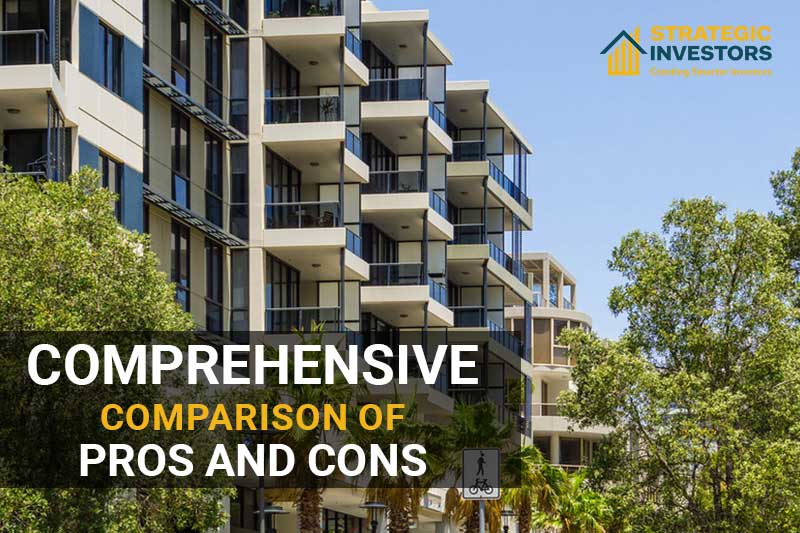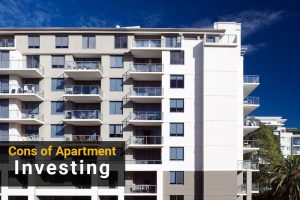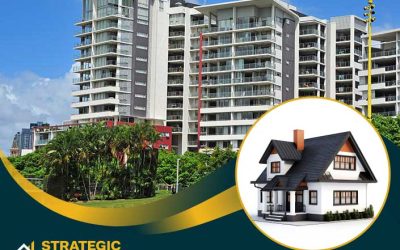
Are you considering investing in an apartment in Australia? You’re not alone. With property prices on the rise and an increasing number of people opting for apartment living, it’s essential to weigh the pros and cons of apartment investments before making a decision. In this blog post, we’ll explore the benefits and drawbacks of apartment investing, compare it to house investments, and provide valuable insights to help you determine if “is an apartment a good investment” for your specific situation.
Key Takeaways
- Investing in an apartment can offer attractive benefits such as affordability, higher rental yields, and shared upkeep costs.
- Potential risks include lower capital growth and body corporate fees.
- Investors should consider factors like location, tenant demand, and market trends to maximize returns from their investment.
Pros of Apartment Investing
 Apartment investments come with a host of advantages that make them an attractive option for many property investors. These benefits include:
Apartment investments come with a host of advantages that make them an attractive option for many property investors. These benefits include:
- Affordability
- Higher rental yields
- Shared upkeep costs
- Location benefits
We’ll now delve into the specifics of these advantages.
Affordability
One of the primary reasons many investors choose apartments over houses is their affordability. With a lower median price, apartments provide a more accessible entry point into the property market, especially for first-time investors or those with limited budgets.
This affordability provides an affordable entry point, allowing investors to potentially enter the market at a lower cost, build their portfolio, and gain valuable experience in property investing without overstretching their finances. It’s no wonder that so many property investors are drawn to apartment investments as a way to break into the market.
Higher Rental Yields
Apartments often offer higher rental yields compared to houses, providing a consistent income stream for investors. This is because apartments are generally more attractive to renters due to their lower rental prices and convenient locations, which can make them easier to rent out.
The demand for apartments is also increasing, as the number of single- and two-person households in Australia continues to grow. This trend means that there is a strong pool of potential tenants looking for apartments, further boosting the rental yields that investors can expect from their apartment investments.

Shared Upkeep Costs

This can help reduce maintenance expenses for individual investors, as there is no garden to take care of and common areas are managed by strata management. This shared responsibility can be a significant advantage for investors who want to minimize their ongoing maintenance costs and maximize their returns.
Location Benefits
Location is a key factor when it comes to property investments, and apartments often have the upper hand in this regard. Apartments are typically situated in prime locations, offering easy access to amenities and public transportation, making them attractive to potential tenants.
This prime positioning means that apartment investments can attract a wider range of tenants, including professionals working in nearby business districts and students attending nearby educational institutions. As a result, the location benefits of apartments can be a major drawcard for investors looking to secure a strong rental income.
Cons of Apartment Investing

- Lower capital growth
- Body corporate fees
- Limited control over renovations
- Potential oversupply issues
We will now examine these potential drawbacks more closely.
Lower Capital Growth
One of the main disadvantages of investing in an apartment compared to a house is the potential for lower capital growth. This is because apartments typically lack land, which is a key driver of capital growth in property investments.
As a result, apartments may not experience the same level of capital growth as houses over the long term, which could impact the overall returns for investors. However, it’s important to remember that higher capital growth is just one aspect of property investing, and the higher rental yields that apartments can provide may help offset any lower capital growth potential.
Body Corporate Fees
Another potential drawback of investing in an apartment is the ongoing expense of body corporate fees. These fees are paid by apartment owners to maintain common areas and facilities within the apartment complex.
While body corporate fees can help to reduce individual maintenance costs, they can also impact the overall returns on an apartment investment. It’s important for investors to carefully consider the impact of body corporate fees on their cash flow and overall investment strategy when deciding whether an apartment investment is right for them.
Limited Control Over Renovations
Apartment investors may face limited control over renovations and improvements due to strata regulations. This can be a significant disadvantage compared to investing in a house, where the owner generally has more freedom to make changes and improvements without requiring approval from a body corporate.
This limited control can make it harder for apartment investors to add value to their property through strategic improvements and renovations, which may impact the potential returns on their investment. It’s essential for investors to be aware of any restrictions on renovations before purchasing an apartment, to ensure they can make the necessary improvements to maximize their returns.
Potential Oversupply Issues
Oversupply of apartments in certain areas can be a concern for investors, as it can lead to reduced rental demand and lower property values. This is particularly relevant in areas with a high concentration of new apartment developments, where the supply of apartments may outstrip demand from potential tenants.
To mitigate the risks associated with oversupply, investors should carefully consider the location and specific market conditions of an apartment investment before making a decision. Choosing an apartment in a desirable location with limited new developments can help minimize the risk of oversupply and ensure a strong rental demand for your investment.
Comparing House vs. Apartment Investments

We will now assess these elements in the context of both house and apartment investments to aid in your decision-making process.
Capital Growth
As mentioned earlier, higher capital growth houses generally offer better capital growth potential than apartments due to land value appreciation. While capital growth is an important factor to consider, it’s essential to weigh this potential against other factors, such as rental yield and maintenance costs, when deciding between a house and apartment investment.
Rental Yield
Rental yield is a crucial factor in determining the success of your property investment. As we’ve discussed, apartments often provide higher rental yields than houses, making them an attractive option for investors seeking a consistent income stream. However, it’s essential to be cautious of properties with a lower rental yield, as they may not generate the desired returns.
However, it’s important to balance rental yield with capital growth potential when making your investment decision.
Maintenance Costs and Upkeep
Maintenance costs and upkeep can vary significantly between houses and apartments. As we’ve seen, apartments typically benefit from shared upkeep costs, which can help to reduce individual maintenance expenses for investors.
On the other hand, houses often come with higher maintenance costs, as the owner is responsible for the entire property, including any gardens or outdoor areas.
Flexibility for Renovations
When it comes to renovations and improvements, houses generally offer more flexibility than apartments. House owners can often undertake renovations without requiring approval from a body corporate, allowing them to add value to their property more easily.
In contrast, apartment investors may face restrictions on renovations due to strata regulations, which can limit their ability to make improvements and potentially impact their investment returns.
Factors to Consider Before Investing in an Apartment

By taking these factors into account, you can make a more informed decision about whether an apartment investment is right for you.
Location and Tenant Demand
The location of an apartment and the demand from potential tenants are crucial factors in determining its investment potential. Choosing an apartment in a desirable location, close to amenities and public transport, can help to attract a wider range of tenants and ensure a strong rental demand for your investment.
In addition, understanding the ratio of renters versus owner occupiers in the area can provide valuable insights into the demand for rental properties and the potential negotiation power of tenants. By carefully considering location and tenant demand, you can maximize the chances of success for your apartment investment.
Market Trends and Conditions
Understanding market trends and conditions is key to making informed decisions about apartment investments. By keeping an eye on the local housing market, the overall economic climate, and the availability of rental properties, you can better gauge the potential success of your investment property.
In particular, it’s important to focus on areas where there is high demand for rental properties and a limited supply, as this can help to ensure strong rental yields and capital growth for your investment.
Potential for Value-Add Opportunities
Identifying apartments with potential for value-add opportunities, such as renovations or improvements, can increase your investment returns. By selecting properties that offer scope for strategic improvements, you can add value to your investment and potentially boost your rental income and capital growth.
However, it’s important to be aware of the risks associated with value-add opportunities, such as potential overcapitalization, unforeseen costs, and delays in completion. By carefully considering the potential for value-add opportunities and weighing the associated risks, you can make a more informed decision about your apartment investment.
Case Studies: Successful Apartment Investments

Boutique apartments are often located in desirable areas, such as near universities, and downtown areas.
Boutique Apartments in Desirable Locations
Boutique apartments in prime locations can offer better investment opportunities than houses in less desirable areas. These apartments are often located in sought-after neighborhoods, close to employment centers, and have a limited supply compared to demand.
By choosing boutique apartments in desirable locations, investors can benefit from higher rental yields, stable tenant demand, and potential for capital growth. This case study highlights the importance of focusing on location and property type when selecting an apartment investment.
Family-Friendly Apartments
Family-friendly apartment buildings with larger floor plans and amenities can be an attractive option for investors looking for stable tenants and strong investment returns. These apartments often appeal to families who desire the convenience of apartment living but still require ample space and facilities to cater to their needs.
By investing in family-friendly apartments, investors can benefit from a diverse tenant base, strong rental demand, and potential for capital growth. This case study underscores the importance of targeting specific tenant demographics and offering apartment options that cater to their needs.
Summary
In conclusion, investing in an apartment in Australia presents both advantages and challenges. Key benefits include affordability, higher rental yields, shared upkeep costs, and location benefits, while potential drawbacks consist of lower capital growth, body corporate fees, limited control over renovations, and potential oversupply issues. By carefully considering factors such as location and tenant demand, market trends and conditions, and potential for value-add opportunities, investors can make more informed decisions about apartment investments and maximize their chances of success.
Frequently Asked Questions

Do apartments go up in value?
Yes, apartments in good locations tend to appreciate in value over time due to increasing demand and market conditions.
What are the pitfalls of buying an apartment?
Buying an apartment has many pitfalls, such as limited space and privacy, expensive body corporate fees, negative equity, parking limitations, and restrictive by-laws.
Living in an apartment can also feel cramped during the pandemic living and not be a good choice for families or pets due to noise and lack of space.
What are the main advantages of investing in an apartment in Australia?
Investing in an apartment in Australia offers the advantages of affordability, higher rental yields, shared upkeep costs, and great location benefits
How do rental yields for apartments compare to those for houses?
Apartments typically have higher rental yields than houses, making them an attractive choice for investors looking to generate income.
Investors can benefit from the higher rental yields and the potential for capital growth that apartments offer. Additionally, apartments are often easier to manage than houses, as they are usually located in close proximity to each other.
What factors should be considered when evaluating the potential capital growth of an apartment investment?
When evaluating the potential capital growth of an apartment investment, location, market conditions, and potential value-add opportunities should be carefully considered.












